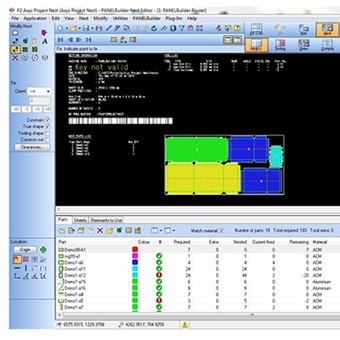 By John Donaldson, AXYZ International
By John Donaldson, AXYZ International
Customization has become a priority for fabricators in the engineered architectural metal and exterior envelope system industry. They must rely on state-of-the-art technology to minimize lead times and deliver projects on time, on budget and within specified tolerances. At the same time, growth demands identification of and entry into new markets where prospects and customers expect extensive customization capabilities from fabricators.
Perhaps the most critical fabrication challenge centers on process. Architectural metal fabricators have to be able to process large volumes of cladding material quickly and efficiently. In the past, the tried and true process for many was the AutoCAD system, which would create a file for each panel for a machine to cut. Others may have relied on programs to cut groups of panels. Both of these options were cumbersome processes.
Today, fabricators are turning to CNC routers accompanied by sophisticated software programs to expedite their processes, increase production capabilities and create new offerings.
Maximizing CNC Routers And Software
 An optimal choice for efficient and rapid processing is an all-in-one system. In this case, the software should be easy to learn, feature parametric modelling of panels and parts, and work in combination with a customized CNC router designed to process composites and other materials consistently, quickly, efficiently and at lower cost. The most efficient and versatile of the routers can accurately and easily cut materials such as aluminum composite material, stainless composite material, titanium, copper, solid aluminum and high-pressure laminates.
An optimal choice for efficient and rapid processing is an all-in-one system. In this case, the software should be easy to learn, feature parametric modelling of panels and parts, and work in combination with a customized CNC router designed to process composites and other materials consistently, quickly, efficiently and at lower cost. The most efficient and versatile of the routers can accurately and easily cut materials such as aluminum composite material, stainless composite material, titanium, copper, solid aluminum and high-pressure laminates.
The more advanced software can operate in 2-D and 3-D, enabling users to build an actual library of panels through a built-in drawing package or by importing existing drawings. The software then generates automatic toolpaths for panel cutting. Because of the different groups of cutting requirements, newer routers can provide dual- and triple-head configurations-a highly efficient and cost-effective method of processing jobs that require two or three different tools.
Another function that fabricators require is traceability, enabling supervisors to input and track programs to ensure that employees are cutting panels correctly from start to finish. An equally important factor is material use. Fabricators justifiably focus on minimizing material waste and maximizing material usage. Here is where nesting-the grouping or arranging of panels to maximize material use-comes into play. A nesting algorithm in the software can utilize simple or complex panel geometry to create more efficiency and speed of production. Projects can also be drawn in AutoCAD or other CAD drafting programs, placed in the software and sent to the CNC router. That is a significant advancement from earlier technology in which most fabricators had to nest each individual file - a time consuming process that ran counter to cost and labor-efficiency.
Using Technology To Improve Estimating
| |  |
| | The other automated estimating benefit is the efficient use of time and labor. ECMS says its use of Burlington, Ontario, Canada-based AXYZ International's PANELBuilder system has enabled the company to accurately determine its workforce needs while completing projects in half the time. |
Perhaps the best news for fabricators is the development of automated technology to vastly improve the estimating process by accurately projecting material yield. East Coast Metal Systems (ECMS), a fabricator and installer located in Bellaire, Ohio, and Wheeling, W.Va., can attest to the value of automated estimating. The company sought to improve the accuracy of its estimating process as well as the ability to perform group panel cutting and customized work required by its growing customer base. It found a technological answer, which enabled it to provide accurate estimates, particularly pertaining to material requirements and usage. ECMS reports its superior estimating capability has positively impacted its ability to competitively price its job estimates.
Customization Provides Important Benefits
Fabricators have a number of options to consider in their decision-making process for evaluating CNC router technology and software for fabricating engineered architectural metal applications. One of the most obvious options is for any customization choice to focus on the potential for future upgrades and integration, given the industry's increasing rate of process change. As these changes occur, it is important for fabricators to set four major goals to guide their decision making process:
1) Accurate and consistent cutting
2) Maximizing material yield
3) The most efficient use of labor
4) Lowering overall production costs
These goals are achievable through efficient and knowledgeable use of customized technology.